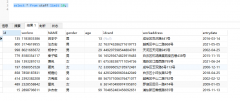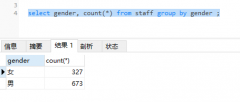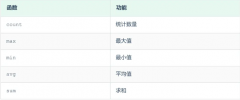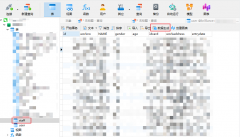SQL 2008 Combining data from multiple rows with the same ID into one row(SQL 2008 将具有相同 ID 的多行数据合并为一行)
问题描述
我在一个表中有数据,其中包含同一 CardNum 的多行数据.我想创建一个表,其中同一 CardNum 的所有数据都显示在同一行上.
I have data in one table that contains several rows of data for the same CardNum. I would like to create a table where all the data for the same CardNum is displayed on the same row.
我的数据目前是这样的:
My data is currently like this:
PartID | CardNumber | RdrGrpID | TZID
0 412 31 1
0 412 34 1
0 567 38 1
0 567 33 5
0 567 71 3
这就是我想要的数据:
PartID | CardNumber | RdrGrpID_1 | TZID_1 | RdrGrpID_2 | TZID_2 | RdrGrpID_3 | TZID_3
0 412 31 1 34 1
0 567 38 1 33 5 71 3
提前谢谢你.
推荐答案
要获得此结果,您可以通过多种方式制定查询.
To get this result, there are several ways that you can formulate the query.
如果每个 partId 和 cardNumber 的值数量有限,则可以将 row_number() 与聚合函数/案例组合:
If you have a limited number of values for each partId and cardNumber, then you can use row_number() with an aggregate function/CASE combination:
select partid, cardnumber,
max(case when rn = 1 then rdrgrpid end) rdrgrpid_1,
max(case when rn = 1 then TZID end) TZID_1,
max(case when rn = 2 then rdrgrpid end) rdrgrpid_2,
max(case when rn = 2 then TZID end) TZID_2,
max(case when rn = 3 then rdrgrpid end) rdrgrpid_3,
max(case when rn = 3 then TZID end) TZID_3
from
(
select partId, cardNumber, RdrGrpID, TZID
, row_number() over(partition by partiD, cardnumber
order by rdrgrpid) rn
from yt
) d
group by partid, cardnumber;
参见 SQL Fiddle with Demo
您也可以使用 PIVOT/UNPIVOT 函数来获取结果:
You could also use the PIVOT/UNPIVOT function to get the result:
select *
from
(
select partid, cardnumber,
col+'_'+cast(rn as varchar(10)) col,
val
from
(
select partId, cardNumber, RdrGrpID, TZID
, row_number() over(partition by partiD, cardnumber
order by rdrgrpid) rn
from yt
) d
unpivot
(
val
for col in (rdrgrpid, tzid)
) un
) s
pivot
(
max(val)
for col in (RdrGrpID_1, TZID_1, RdrGrpID_2, TZID_2,
RdrGrpID_3, TZID_3)
) piv
请参阅 SQL Fiddle with Demo.
现在,如果您有未知数量的值,那么您将需要使用动态 sql:
Now if you have an unknown number of values, then you will need to use dynamic sql:
DECLARE @colsPivot AS NVARCHAR(MAX),
@query AS NVARCHAR(MAX)
select @colsPivot = STUFF((SELECT ',' + QUOTENAME(c.col + '_'+cast(rn as varchar(10)))
from
(
select row_number() over(partition by partiD, cardnumber
order by rdrgrpid) rn
from yt
) t
cross apply
(
select 'RdrGrpID' col, 1 so union all
select 'TZID', 2
) c
group by col, rn, so
order by rn, so
FOR XML PATH(''), TYPE
).value('.', 'NVARCHAR(MAX)')
,1,1,'')
set @query
= 'select partid, cardnumber, '+@colsPivot+'
from
(
select partid, cardnumber,
col+''_''+cast(rn as varchar(10)) col,
val
from
(
select partId, cardNumber, RdrGrpID, TZID
, row_number() over(partition by partiD, cardnumber
order by rdrgrpid) rn
from yt
) d
unpivot
(
val
for col in (rdrgrpid, tzid)
) un
) s
pivot
(
max(val)
for col in ('+ @colspivot +')
) p'
exec(@query);
参见 SQL Fiddle with Demo.所有版本都给出结果:
See SQL Fiddle with Demo. All versions gives the result:
| PARTID | CARDNUMBER | RDRGRPID_1 | TZID_1 | RDRGRPID_2 | TZID_2 | RDRGRPID_3 | TZID_3 |
-----------------------------------------------------------------------------------------
| 0 | 412 | 31 | 1 | 34 | 1 | (null) | (null) |
| 0 | 567 | 33 | 5 | 38 | 1 | 71 | 3 |
这篇关于SQL 2008 将具有相同 ID 的多行数据合并为一行的文章就介绍到这了,希望我们推荐的答案对大家有所帮助,也希望大家多多支持编程学习网!
本文标题为:SQL 2008 将具有相同 ID 的多行数据合并为一行


基础教程推荐
- ORA-01830:日期格式图片在转换整个输入字符串之前结束/选择日期查询的总和 2021-01-01
- while 在触发器内循环以遍历 sql 中表的所有列 2022-01-01
- 从字符串 TSQL 中获取数字 2021-01-01
- 带更新的 sqlite CTE 2022-01-01
- 使用 VBS 和注册表来确定安装了哪个版本和 32 位 2021-01-01
- 带有WHERE子句的LAG()函数 2022-01-01
- 如何在 CakePHP 3 中实现 INSERT ON DUPLICATE KEY UPDATE aka upsert? 2021-01-01
- MySQL根据从其他列分组的值,对两列之间的值进行求和 2022-01-01
- CHECKSUM 和 CHECKSUM_AGG:算法是什么? 2021-01-01
- MySQL 5.7参照时间戳生成日期列 2022-01-01

















